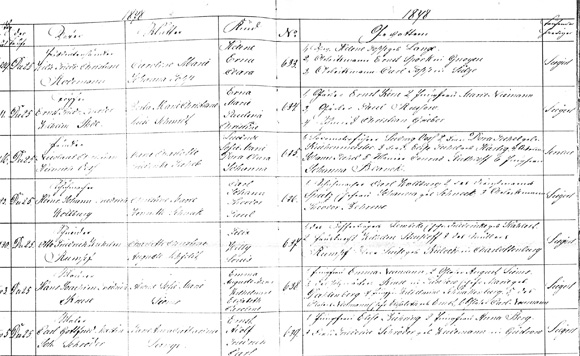November 02, 2016 | News | RAPHIS
New database with individual statistics from the 19th century
The database RAPHIS (Rostock Archives of Historical Vital Statistics Microdata) has gone online recently. It contains individual data from censuses, church registries and death registers in Rostock from 1800 to 1905.
Margarethe Emma Ida Ottilie Schmidt was married to Detective Superintendent
Karl Hermann Conrad Gustav Fritsch on May 19, 1904 in St. Marien Church, Rostock.
Such statement was made in the Church Book of the St. Marien parish in Rostock. In a census held four years earlier, said detective superintendent was probably still a simple police cadet. And we learn from the census data that he was not a native inhabitant of Rostock, but was born in Oels-Breslau in Silesia. We do not know for sure whether the Konrad recorded in the census is the same as the one who married on May 19, 1904, because the census registered only the name by which he was known: his first name, Konrad, with a "K" rather than a "C" (as in the Church Book).
"It is normal that these records contain errors," says MPIDR researcher Rembrandt Scholz, who has launched the database with colleagues from the University of Rostock and the former MPIDR research group Historical Demography. The original handwritten data have errors. Mistakes may also have been made during digitization, i.e. when student assistants spent thousands of working hours transferring the data to the database. Still, the data in the database is a little treasure: "Usually, you find data of this form and completeness only for smaller villages; Rostock is an exception here”, says the researcher.

Excerpt from the Church Book of the St. Jakobi perish in Rostock from 1878.
The database, called RAPHIS (Rostock Archives of Historical Vital Statistics Microdata), contains approximately 230,000 individual records and is available free of charge after registration. The data come from the church registers of the four Rostock churches that existed at that time and from the three censuses of 1819, 1867, and 1990. The data from the church books provide information on the name, birth, baptism, confirmation, and the death of parish members. The censuses registered the name, age, sex, the household, and the occupation of the household head.
"The important thing is that we now have access to data that have not only one dimension", explains Rembrandt Scholz. On the basis of these individual data, multi-dimensional in nature, it is possible, for example, to reconstruct historical events very well, such as the abolition of the guild statutes. Before the abolition, journeymen by statue were only allowed to work in the business of their master; and only when they themselves became masters were they allowed to marry. With the abolition of the guild statutes, you can see that the first business companies started to develop.
But demographic changes too, such as the increase in life expectancy, high immigration rates and the low birth rate, can be derived from the data. Apart from the historical insights we gain from the database, the database also helps us to understand developments of today. "Demographic processes are slow. That's why we have to look into the past if we want to understand and evaluate current demographic trends”, says the scientist.
More Information
RAPHIS - Database website